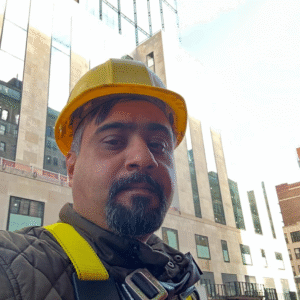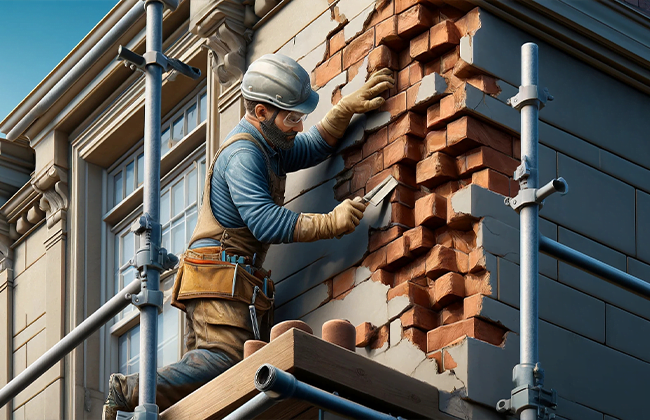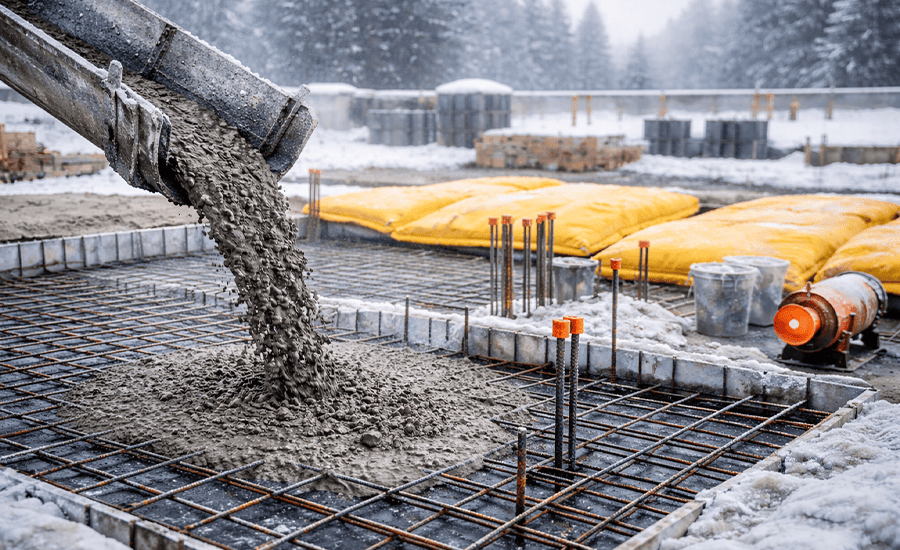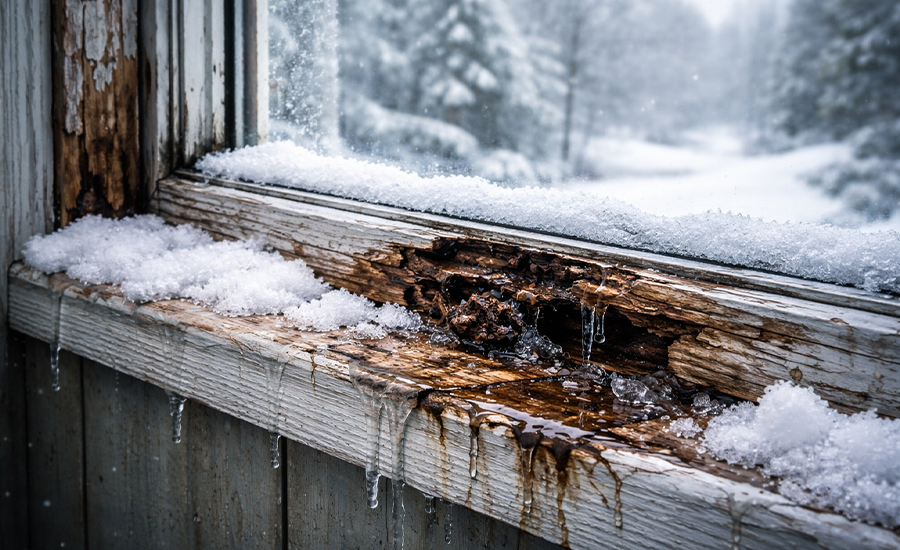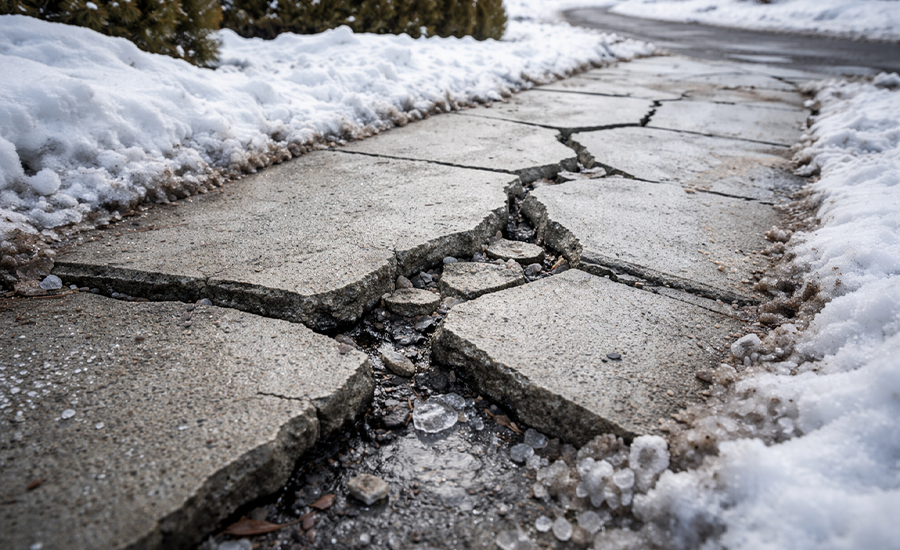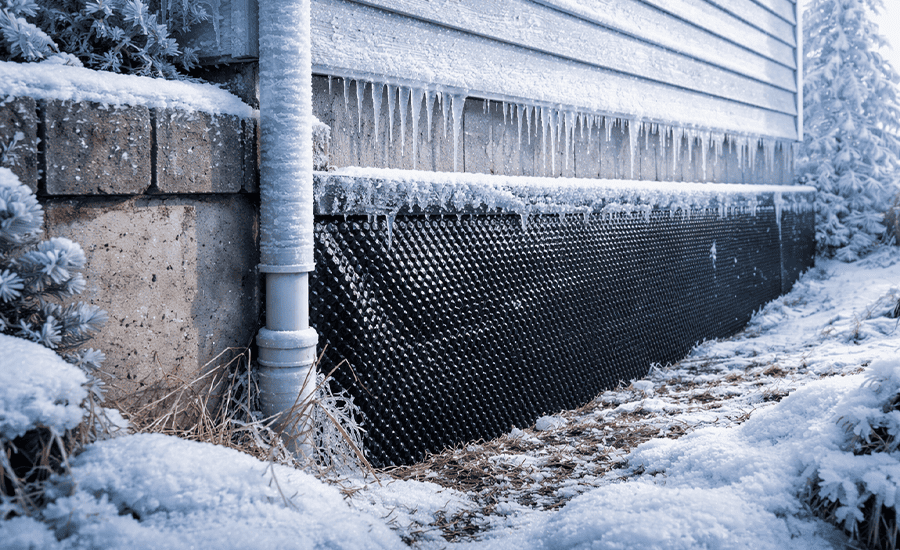Brick face repair is an essential practice to maintain the structural integrity and aesthetic appeal of your property. It involves fixing damaged bricks and repointing mortar joints to prevent further deterioration and potential safety hazards. Addressing issues early can save significant costs and extend the lifespan of the brickwork, making brick face repair a crucial maintenance step for any homeowner.
What is Brick Face Repair?
Brick face repair is an essential maintenance process focused on correcting imperfections and damage on the exterior surface of brick structures. This damage can occur due to various factors, including environmental conditions, physical impacts, and the natural aging process. Repairing the brick face not only restores its original aesthetics but also fortifies the structure, ensuring it remains durable against future adversities.
Signs You Need Brick Face Repair
When it comes to maintaining the structural integrity and appearance of your brickwork, recognizing the signs that you need repairs can save you from more extensive and expensive problems down the line. Here’s a closer look at the indicators that suggest it’s time for some brick face repair:
- Crumbling or Loose Bricks: If you start noticing that bricks are not as firm as they used to be or bits of brick are falling off, it’s a sign that the structural integrity of the brickwork may be compromised. This can be due to weather exposure or simply the age of the bricks. Immediate attention can prevent further deterioration.
- Visible Cracks on the Brick Face: Cracks can appear small at first but have the potential to grow and become serious issues. They are not only unsightly but can also let in moisture, which further damages the wall. Monitoring and addressing these cracks early on can help maintain the stability and efficiency of moisture prevention in your brickwork.
- Discoloration and Staining: While often overlooked as merely cosmetic, discoloration can indicate more serious issues. For example, white powdery stains (efflorescence) are caused by water seeping through and dissolving the natural salts in the bricks, which then crystallize on the surface. Other stains might be related to mold or mildew, which thrive on the moisture trapped within the bricks.
- Mortar Deterioration: The mortar is crucial for holding the bricks together; if you see it crumbling, it’s a warning sign that the adhesive qualities are weakening. Deteriorated mortar can significantly reduce the wall’s ability to withstand environmental stresses and can lead to water infiltration, further accelerating damage to the entire structure.

Benefits of Timely Brick Face Repair
Timely repair of the brick face is not just about keeping your building looking its best; it also brings several practical benefits that can save you money and trouble over time. Let’s explore why it’s wise to address brick face issues sooner rather than later.
- Extends the Lifespan of Your Building: Regular maintenance, including brick face repair, can significantly extend the life of a building. Bricks and mortar exposed to the elements can deteriorate quickly if not maintained. By fixing small issues like cracks or loose bricks, you prevent them from turning into bigger, more costly problems, thereby prolonging the structure’s overall lifespan.
- Prevents Water Intrusion and Related Damage: One of the most critical benefits of timely brick face repair is preventing water from seeping into your building. Water intrusion can lead to several problems, including mold growth, interior damage, and thermal inefficiency. By sealing cracks and replacing deteriorated mortar, you keep the building dry and reduce the risk of moisture-related damages.
- Enhances Curb Appeal and Property Value: The appearance of your building makes a significant first impression. Well-maintained brickwork enhances the building’s curb appeal, making it more attractive to visitors, customers, or potential buyers. Consequently, this can also increase the property’s market value, giving you a better return on your investment should you choose to sell.
- Improves Structural Stability: Bricks and mortar collectively support the structural integrity of a building. When the brick face is compromised, so too is the building’s stability. Timely repairs ensure that the structural elements remain robust and can withstand external pressures, from harsh weather to natural aging.
Common Techniques in Brick Face Repair
When it comes to restoring the integrity and appearance of brickwork, several techniques can be particularly effective. Each method targets specific issues, ensuring that your brick face remains in top condition. Here’s a closer look at the most common repair techniques:
Repointing:
Repointing is the process of renewing the pointing, which is the external part of mortar joints, in masonry construction. Over time, weathering and decay cause voids in the joints between masonry units (bricks), usually due to exposure to water and frost. Repointing is crucial because it prevents water from entering into the masonry, which can cause significant damage. The process involves removing the old mortar to a required depth and then filling it with new mortar.
Brick Replacement:
Sometimes, the damage to brickwork is beyond just the mortar. Bricks can crack, chip, or become too worn to function properly. In such cases, replacing the damaged bricks is necessary. This technique involves carefully removing the compromised bricks and replacing them with new ones that match the original as closely as possible in terms of color and texture. This not only restores the structural integrity of the brickwork but also keeps the façade looking uniform and attractive.
Cleaning and Sealing:
Over time, brick faces can accumulate stains from dirt, pollutants, and biological growth such as moss and mold. Cleaning these surfaces can significantly enhance the aesthetic appeal of the building. Specialized cleaning agents or pressure washing are often used to remove these stains. Once clean, applying a sealant can protect the bricks from moisture penetration and reduce the likelihood of future stains and damage. Sealants help to repel water, thereby prolonging the life of the masonry work and maintaining its appearance.
These repair techniques not only help in maintaining the beauty of your brick structure but also fortify its durability against future damage, ensuring your building remains safe and sound for years to come.

Step-by-Step Process of Brick Face Repair
Repairing the face of your brickwork can seem daunting, but breaking it down into manageable steps makes the process much more approachable. Here’s a detailed guide on how to tackle brick face repair from start to finish:
1. Assessment
Begin with a thorough inspection of the brickwork to identify any damage. Look for signs like cracks, loose bricks, and deteriorating mortar. This step helps in determining the extent of the repair needed and the materials you will require.
2. Preparation
Once you’ve assessed the extent of damage, prepare the area by removing any loose material from the brickwork. This might involve chiseling out unstable mortar and brushing away debris. Gather all necessary tools and materials such as chisels, mortar mix, trowels, and safety equipment.
3. Repointing
If the mortar has been identified as damaged or decayed, it’s time to repoint. Carefully mix the new mortar to match the existing color and consistency as closely as possible. Apply the mortar into the cleaned-out joints, using a trowel to push it in firmly and ensure it’s well-packed.
4. Replacement
In cases where bricks are too damaged to be repaired, they should be replaced. Remove the damaged brick entirely, clean the space, and insert a new brick that matches the old in size, color, and texture. Use the fresh mortar to set the new brick in place.
5. Cleaning
After the repairs, clean the entire area to remove any excess mortar and dust. This can be done with a gentle wash using a sponge and water, or for tougher stains, a mild detergent might be necessary.
6. Sealing
The final step is to apply a sealant over the brickwork. This will help protect the newly repaired mortar and bricks from moisture and weathering, extending the life of your repairs.
Table: Materials and Tools for Brick Face Repair
| Material/Tool | Purpose | Details |
| Mortar Mix | For repointing | Match to existing mortar in color and texture |
| Trowel | For applying mortar | Used to place and spread mortar in joints |
| Chisel | For removing damaged mortar/brick | Used to carefully remove old mortar and bricks |
| Safety Equipment | For protection | Includes gloves, goggles, and dust mask |
| New Bricks | For replacement | Should match the existing bricks in size and color |
| Mild Detergent | For cleaning | Used for tougher cleaning needs after repair |
| Sealant | For sealing brickwork | Applied after repair to protect against moisture |
Following these steps systematically not only ensures that the repairs are done thoroughly but also helps maintain the structural integrity and aesthetic appeal of your brickwork. With the right tools and a bit of patience, you can effectively extend the life of your brick structures.
Choosing the Right Materials for Brick Face Repair
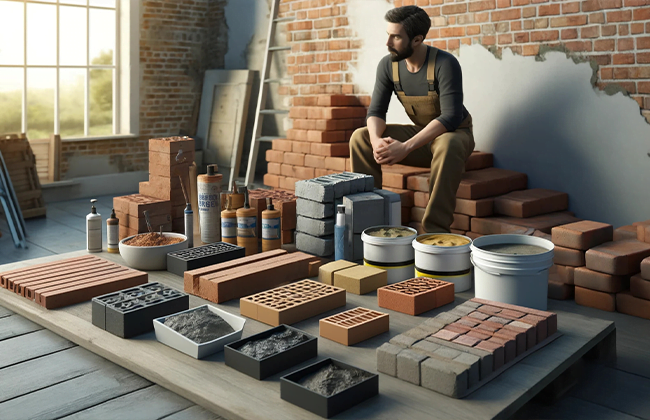
Selecting appropriate materials is crucial for effective brick face repair, ensuring not only the longevity of your repairs but also that they blend seamlessly with the existing structure. Here’s a guide on how to choose the right materials:
1. Mortar
The mortar used in the repair process needs to closely match the existing mortar in your building. This is important both for the aesthetics and the structural integrity of the brickwork. The consistency, color, and strength of the new mortar should align with the old to avoid a patchy appearance and to ensure that the new joins are as durable as the original. To achieve this, you might need to take a sample of the existing mortar to a specialist who can formulate a matching mix.
2. Bricks
When it comes to replacing damaged bricks, finding a match that complements the original structure is essential. This involves considering not just the color but also the size, texture, and age of the bricks. Using new bricks that are vastly different can lead to a disjointed appearance, reducing the overall aesthetic appeal of the building. If exact matches are not available, consider sourcing reclaimed bricks from a similar aged building or having custom bricks made if the budget allows.
Understanding the properties and performance requirements of your building’s materials is fundamental to maintaining its historic value and structural health. Always consult with a materials expert or a structural engineer when unsure about the types of materials needed for your specific repair job.
DIY Tips for Minor Brick Face Repair
Tackling minor brick face repairs yourself can be a rewarding project that saves money and maintains the integrity of your building. Here are some key tips to ensure that your DIY repair efforts are effective, safe, and produce a finish that complements your home’s overall appearance.
Safety First
Safety cannot be overstressed when undertaking any form of construction work, including minor brick repairs. Always wear protective gear to shield yourself from potential hazards. Essential safety equipment includes gloves to protect your hands, goggles to shield your eyes from flying debris, and a dust mask to prevent inhalation of harmful dust and particles. Additionally, if you’re working at height, ensure you use a stable ladder or scaffolding, and consider a hard hat.
Matching Mortar
One of the key aspects of ensuring that your repair work is not only effective but also aesthetically pleasing is to match the new mortar to the existing mortar as closely as possible. This involves not just matching the color but also the texture and consistency. You might need to experiment with different mixes to get it just right. Consider purchasing a pre-mixed mortar that is designed to match historical properties if you are working on an older building.
Proper Tools
Using the right tools can make a significant difference in the quality and ease of your repair work. Essential tools for brick face repair include a pointing trowel for applying mortar, a chisel and hammer for removing old mortar, and a stiff brush for cleaning out joints. For more precise work, consider a joint raker to remove old mortar without damaging the bricks. Additionally, a spirit level can help ensure that your repairs are even and aligned with the existing brickwork.
By following these tips, you can handle minor repairs confidently, keeping your brick face looking great and functioning well. Remember, for more significant damage or structural issues, you should consult with or hire a professional mason to ensure they complete the repairs safely and correctly.

When to Call a Professional
While many minor brick face repairs can be handled through DIY efforts, certain situations require the expertise of a professional. Knowing when to call in a specialist can save you from exacerbating the problem and incurring higher costs down the line. Here are some scenarios where professional help is crucial:
Extensive Damage
If the damage to your brickwork is extensive, covering large areas of the facade, it’s time to call a professional. This type of deterioration can be indicative of deeper structural issues that require professional assessment and repair techniques that go beyond surface-level fixes. A professional can ensure they address any underlying problems and perform a thorough repair.
Structural Issues
A professional should immediately evaluate any signs of foundational movement, such as major cracks or shifting bricks. These symptoms may indicate serious structural issues that could compromise the integrity of the entire building. Professionals bring not only the right tools but also an understanding of structural dynamics to ensure that repairs support the overall stability of the structure.
Historical Buildings
If you’re dealing with a historical building, maintaining the architectural integrity while making necessary repairs is paramount. Professionals who specialize in historical restorations have the expertise to use appropriate materials and techniques that preserve the original character of the building. Their work ensures that repairs enhance the building’s historical value and adhere to any local regulations governing historical landmarks.
Engaging a professional in these scenarios not only ensures safety and structural integrity but also maintains the aesthetic and historical significance of your property. Always consider professional advice to handle complex or significant damage, ensuring the longevity and beauty of your brickwork.
Conclusion
If you’ve identified the need for brick face repair and are looking for a professional contractor to handle the job, ensure you choose someone with the expertise to restore your property’s beauty and strength. For expert brick face repair services, feel free to contact us at (+1) 917-355-8556. Our team is ready to help you secure and beautify your brickwork with precision and care.
FAQs
Q: What is involved in brick face repair?
A: Brick face repair typically includes several steps. These are the assessment of damaged areas, removal of deteriorated mortar, and replacement or repointing of bricks. This process helps maintain the structure’s integrity and appearance.
Q: How often should brick face repair be conducted?
A: The frequency of brick face repair depends on the building’s exposure to elements and the initial construction quality. Generally, inspecting brickwork every few years can help identify when repairs are necessary.
Q: What are the indicators that masonry restoration is necessary?
A: Indicators that suggest the need for masonry restoration include visible cracks, loose or crumbling bricks, and eroded mortar. Promptly addressing these signs can prevent more extensive damage.
Q: Can I undertake masonry restoration on my own?
A: While you can DIY minor masonry restoration tasks, professionals should handle significant repairs. They ensure safety and efficacy in structural repairs.
Q: Why is it crucial to address masonry issues promptly?
A: Addressing masonry issues promptly prevents minor issues from escalating. This protects the building from structural damages. It also avoids potentially higher repair costs in the future.


